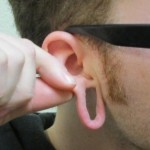Otoplasty: Ear Deformities, Ear Reconstruction and Gauge Repair
Otoplasty and ear reconstruction procedures are used to restore the normal appearance to the external ear. The need for such procedures can be caused by a wide range of situations ranging from birth defects, wearing of large jewelry over time or some type of trauma. If the need for otoplasty or ear reconstruction is caused by a birth defect or accident it may be covered under insurance. However if the ear abnormality was caused by an external force such as the wearing of large jewelry or ear gauges it will be considered an elective cosmetic procedure. Otoplasty can take many forms, such as bringing the ears closer to the head (often called ear pinning), reducing the size of very big ears, or reshaping various bends in the cartilage. Other reconstructive procedures deal with the deformed, or absent (microtic) ears. Otoplasty surgery can involve a combination of moving, reshaping, adding, or removing structural ear elements.
For many ear operations, one or more incisions give access to the structures to be sculpted. The main, and often only incision, is behind the ear. Other possible incisions depend on what needs to be done. Through the incision behind the ear, the concha bowl can be moved closer to the head, a small tunnel created along the front of a poorly folded anthihelix weaken this cartilage, sutures placed to reshape the anti-helix fold, and to balance the ear lobe with the rest of the ear.
Ear reduction otoplasty may involve reducing one or more components of the ear. Incisions are typically hidden near folds in the front when a part of this surgery.
Addressing Microtia (small ear deformity) or Anotia (missing ear deformity) involve augmentation or adding elements to replace deformed or missing structures. Cartilage from the ear or rib are the most common for these more extensive reconstructions. Other ear shapes may be changed through moving, adding, and weakening ear structures.
Internal sutures often are permanent. The wound(s) are then closed with either dissolvable sutures or ones that are removed by Dr. Dehghan after the wounds have healed. An ear dressing protects the ear after surgery.
Once a patient has determined their wish to correct their situation they are welcomed to schedule a consultation with Dr. Dehghan to discuss their options. During the consultation, Dr. Dehghan will discuss the desired results you are wishing to achieve, technical aspects of the procedure and the results you can expect.

